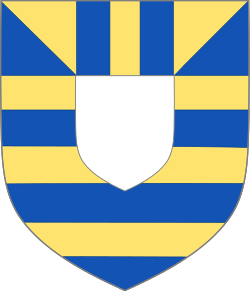Roger Mortimer of Wigmore
Roger de Mortimer (before 1153-before 8 July 1214) was a medieval marcher lord, residing at Wigmore Castle in the English county of Herefordshire. He was the son of Hugh de Mortimer (d. 26 February 1181)[1] and Matilda Le Meschin.

Early life
Roger would appear to have been of age in 1174 when he fought for King Henry II against the rebellion of his son, Henry. In 1179 Roger was instrumental in the killing of Cadwallon ap Madog, the prince of Maelienydd and Elfael, both of which Mortimer coveted.[2] He was imprisoned until June 1182 at Winchester for this killing.[2]
Children
He had married Isabel (d. before 29 April 1252), the daughter of Walchelin de Ferriers of Oakham Castle in Rutland before 1196.[3] With Isabel, Roger had three sons and a daughter:
- Hugh de Mortimer (d. 1227) – married Annora (Eleanor) de Braose, daughter of William de Braose and his wife Maud
- Ralph de Mortimer (d. 1246)
- Philip Mortimer
- Joan Mortimer (d. 1225) – married May 1212 to Walter II de Beauchamp (1192-1236) and they had a son William III de Beauchamp (1215-1269) who married Isabella de Mauduit. They had a child William de Beauchamp, 9th Earl of Warwick (1237–1298).
Roger is often wrongly stated to have been the father of Robert Mortimer of Richards Castle (died 1219) - married Margary de Say, daughter of Hugh de Say. But this Robert was born before 1155 and therefore could not have been a son of Roger.
Lord of Maelienydd
In 1195 Roger, with the backing of troops sent by King Richard I, invaded Maelienydd and rebuilt Cymaron Castle.[4] In 1196 he joined forces with Hugh de Say of Richards Castle and fought and lost the battle of New Radnor against Rhys ap Gruffydd,[5] allegedly losing some forty knights and a large number of foot in the fight. By 1200 he had conquered Maelienydd and issued a new charter of rights to Cwmhir Abbey. In the summer of 1214 he became gravely ill and bought from King King John the right for his son to inherit his lands while he still lived. He died before 8 July 1214.
References
- Crump 1997, p. 117-118.
- Crump 1997, p. 118.
- Powicke 1960, p. 338.
- Crump 1997, p. 119.
- Crump 1997, p. 120.
Sources
- Crump, J.J. (1997). "The Mortimer Family and the Making of the March". In Prestwich, Michael; Britnell, R. H.; Frame, Robin (eds.). Thirteenth Century England VI: Proceedings of the Durham Conference 1995. The Boydell Press.CS1 maint: ref=harv (link)
- Powicke, Frederick Maurice (1960). The Loss of Normandy, 1189-1204: Studies in the History of the Angevin Empire. Manchester University Press.CS1 maint: ref=harv (link)
- Remfry., P. M., Wigmore Castle Tourist Guide and the Family of Mortimer (ISBN 1-899376-76-3)
- Cokayne, George E. Complete Peerage of England, Scotland, Ireland, Great Britain and the United Kingdom/13 Volumes Bound in 6 Books, IV:191; IX:272-3
- Dugdale, William, Monasticon
- IV, Kington St Michael Nunnery, Wiltshire III
- VI, Wigmore Abbey, Herefordshire III, Fundationis et Fundatorum Historia
- Annales de Theokesberia
- Annales de Wigornia